Teledyne e2v Sensor Setup Guide
This guide describes the installation and setup of e2v intraoral sensors for use with Dentrix Ascend Imaging.
Last updated: 11/1/2025
Overview
Dentrix Ascend Imaging supports the acquisition of intraoral images from e2v intraoral X-ray sensors on a computer running the Windows operating system. Drivers for the e2v sensor must be installed on each computer that the e2v sensor will be connected to. Calibration (correction) files must be installed on each computer that the e2v sensor will be connected to.
e2v sensors are rebranded and sold by many companies under their specific brand names. The following devices work in Dentrix Ascend Imaging with e2v selected as the acquisition device:
-
Dentimax Dream sensor
-
EVA Select sensor
-
Sota/Clio sensor
-
XDR sensor
-
Apteryx Tuxedo sensor (previous version is Hamamatsu which is also directly supported by Imaging)
-
QuickRay HD sensor (previous version is Hamamatsu which is also directly supported by Imaging)
Notes:
-
e2v and Progeny sensors are not able to function on the same machine. If you are changing from a Progeny sensor to an e2v sensor, see the Troubleshooting section at the end of the document.
-
Prior to the installation of the e2v sensor, the acquisition agent application must be installed on each computer that will acquire images. Refer to Setting up the acquisition agent for instructions on downloading and installing the acquisition agent.
Configuring Correction Files
To configure the correction files for e2v sensor drivers, do the following:
-
Click the Acquisition Agent icon in the notification area of the Windows taskbar, and then select Preferences.

-
Select the Digital Sensor tab.

-
Note the Correction Path under e2v. Either copy the correction files to the specified directory, or click Browse and select the location where the correction files are stored.
Note: The calibration file requires the format: [serial number].raw. If there are any characters other than the serial number in the name of the calibration file, or if the file extension is anything other than .raw, the calibration file will not work. Renaming the calibration file to include only the serial number and changing the file extension to .raw should resolve the issue. For example, if the calibration file is named SN507244.cal, change it to 507244.raw. The following types of calibration files are possible: .raw, .cal, and .ffc.
Testing
The e2v sensor is now functional in Dentrix Ascend Imaging. To acquire a test image, do the following:
-
Select the 1 Bitewing imaging procedure.
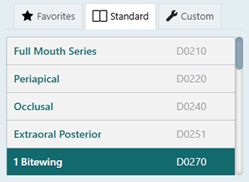
-
Select any teeth for the test.
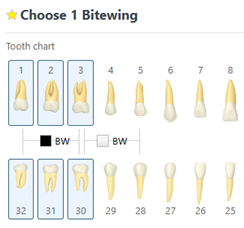
-
On the Available Devices menu, select e2v.

-
Click Start.

-
Acquire an image using the e2v sensor.
Adjusting Sensor Settings
To adjust the e2v sensor settings in the acquisition agent preferences, do the following:
-
Click the Acquisition Agent icon in the notification area of the Windows taskbar, and then select Preferences.

-
Select the Digital Sensor tab, and then click e2v Settings.
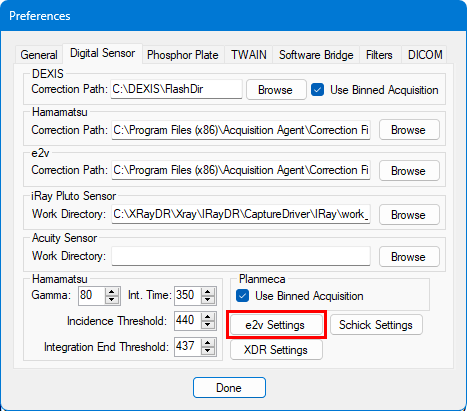
-
Change any of the following settings: Binned Acquisition, Sensor Gain, Integration Time, Triggering Level, and Gamma Level. Then, click Done.

-
Select the Filters tab.
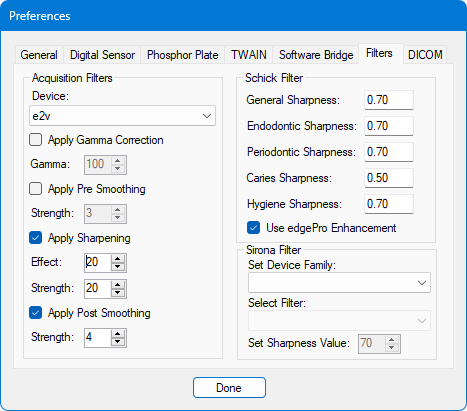
-
Under Acquisition Filters, select e2v from the Device list, and then make any additional adjustments as needed.
-
Click Done.
Size-2 XDR Sensor Rotation
If you are using a size-2 XDR sensor with the e2v integration, the Rotate Size 2 Image (XDR) checkbox must be selected in the acquisition agent preferences. On the Digital Sensor tab, click e2v Settings to access the e2v Sensor Settings dialog box.
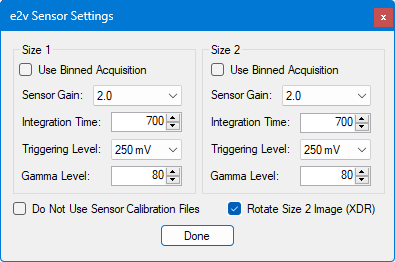
Note: Images from all size-2 sensors will be rotated if this checkbox is selected.
Removing Progeny Sensor Files
To remove drivers for any Progeny sensors that were used previously, do the following:
-
Uninstall the Progeny Device Suite.

-
Uninstall the Acquisition Agent.


-
Reinstall the Acquisition Agent.
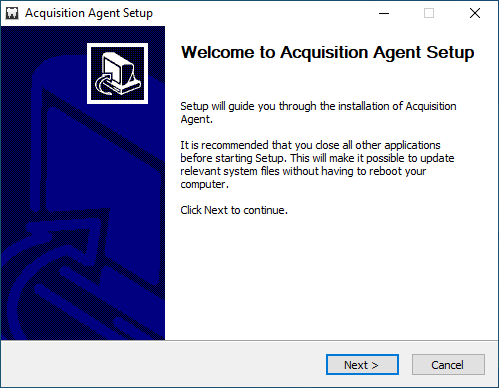
-
Restart the computer.
The e2v sensor should now work on the computer.
Troubleshooting
If the sensor is not working properly do the following:
-
Make sure that the sensor is detected by the computer. Open Device Manager, and then verify that the device appears.
-
Make sure that the Correction Path under e2v on the Digital Sensor tab is correct in the acquisition agent preferences and that the applicable correction files exist in that location.
-
Restart the computer.